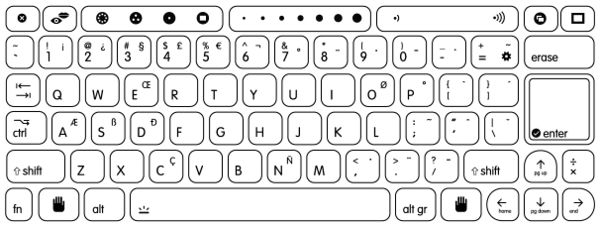Keyboard
Image:Support-banner-square.png|173px|community support pages rect 0 0 135 204 [1] rect 135 0 345 204 Support FAQ rect 0 205 135 408 [2]
- Comment : there's some whitespace here:
rect 135 205 345 408 Other support
- maybe desc none is better. testing.
desc none
</imagemap>See Also Keyboards and key bindings
Contents
Special Keys
The XO keyboard has a number of special keys and keycap symbols:
- the Esc key has a white × inside a black circle (
 );
); - the Frame key has an open rectangle on it (
 );
); - the F1 key is the same as the Neighborhood View key (
 );
); - the F2 key is the same as the Group View key (
 );
); - the F3 key is the same as the Home View key (
 );
); - the F4 key is the same as the Activity View key (
 );
); - the Delete key is the same as Fn-Erase.
Caps Lock
There is no Caps Lock key. However, in a future software release, there will be a way to create Caps Lock behavior in the Write Activity.
Languages other than English
We support the following keyboard layouts: English (US international), Spanish (Argentine), Portuguese (Brazilian), Amharic (Ethiopian), Arabic (Libyan), West African (Nigerian), French (Rwanda), Thai, Urdu, Cyrillic, Turkish, Nepali, Devanagari, Mongolian, Kazakh, Uzbek, Pashto, and Dari.
To see what languages are currently supported, go to Manufacturing Data#Keyboards.
You can also click on the link to each language to find out how to configure the keyboard layout. For activity localization, see Sugar Control Panel. However, please be advised that some configurations may cause the machine to behave abnormally (#5559).
If the characters do not display correctly, you might need to install language-specific font(s). Drop the ttf file into /usr/share/fonts and rerun fc-cache.
Typing Non-English characters
Many common characters can be typed directly as well by using the AltGr key in combination with other keys. For example, on the US keyboard:
- AltGr+c to type cedilla (ç);
- AltGr+n to type n with a tilde (ñ);
- a followed by AltGr+4 to type a with an accent acute (á);
- e followed by AltGr+3 to type e with an accent grave (è).
Many (but not all) activities also let you enter Unicode directly: Hold down the Ctrl+Shift keys while you type u followed by the 4-digit code point for the character you want, e.g., Ctrl+Shift+u03A9 to type the Greek capital letter Omega (Ω). (You need to hold the Ctrl and Shift keys while you type all five characters.)
